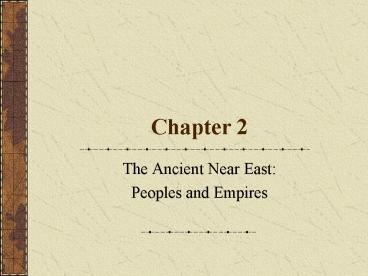The Ancient Near East: - PowerPoint PPT Presentation
1 / 25
Title:
The Ancient Near East:
Description:
Moses leads them out of Egypt (Exodus) 12 Tribes. Troubles with ... Assyria conquers Kingdom of Israel (722 B.C.) Chaldeans conquered Kingdom of Judah (586 B.C. ... – PowerPoint PPT presentation
Number of Views:139
Avg rating:3.0/5.0
Title: The Ancient Near East:
1
Chapter 2
- The Ancient Near East
- Peoples and Empires
2
Timeline
3
The Hebrews The Children of Israel
- Hebrew Bible Old Testament
- Descendants of Abraham
- Migration to Egypt
- Slaves of Pharaohs
- Moses leads them out of Egypt (Exodus)
- 12 Tribes
- Troubles with the Philistines
- Origins of United Kingdom (c. 1200 c. 1000 B.C.)
4
Chronology The Israelites
5
The United Kingdom
- Saul (c. 1020 1000 B.C.)
- David (c. 1000 970 B.C.)
- Solomon (c. 970 930 B.C.)
- Temple of Jerusalem
- Arc of the Covenant
6
Map 2.1 Palestine in the First Millennium B.C.
7
The Divided Kingdom
- Kingdom of Israel
- 10 Northern Tribes
- Capital in Samaria
- Kingdom of Judah
- 2 Southern Tribes
- Capital in Jerusalem
- Assyria conquers Kingdom of Israel (722 B.C.)
- Chaldeans conquered Kingdom of Judah (586 B.C.)
- Jerusalem Destroyed
- Babylonian Captivity
8
Spiritual Dimensions of Israel
- Yahweh (Monotheism)
- Covenant, Law and Prophets
- Covenant with Yahweh
- Laws
- 10 Commandments
- Regulation of economic, social and political life
of all Hebrews - Prophets
- Yahwehs voice to his people
- Universalism and Social Justice
- Separation between Jews and non-Jews
9
The Social Structure of the Hebrews
- Social Patterns
- Family was the central social institution of
Hebrew life - Marriage and Women
- Monogamy versus Polygamy
- Dependence of women on men
- Goal of marriage was the production of children
10
The Neighbors of the Israelites
- Philistines
- Phoenicians
- Trade
- Colonies throughout the Mediterranean
- Carthage
- Transmitters of Culture
- Alphabet
11
Table 2.1 A Comparison of the Phoenician, Greek,
and Latin Alphabets
12
Map 2.2 The Assyrian and Neo-Babylonian Empires
13
The Assyrian Empire
- Semitic Language
- Iron Weapons
- Ashurbanipal (669 626 B.C.E.)
- Governing the Empire
- Absolute Kings
- Well-Organized Empire
- Military
- Size
- Discipline
- Weapons
- Tactics
- Terror
14
Ashurbanipal Destroys an Elamite City
15
Assyrian Society and Culture
- Imported Prisoners of War
- Language
- Religion
- Agriculture
- Trade
- Middlemen
- Hybrid Culture
- Guardians of Sumerian and Babylonian Culture
- Art
- Relief Sculptures
16
King Ashurbanipuls Lion Hunt
17
The Neo-Babylonian Empire
- Rise of the Chaldeans
- Reign of Nebuchadnezzar II (625 605 B.C.)
- Economic Prosperity
- The City of Babylon
- Fall of Babylon to Persians (539 B.C.)
18
The Persian Empire
- Cyrus the Great (559 530 B.C.)
- Conquered Kingdom of Lydia (c. 547 B.C.)
- Conquered Greek city-states
- Conquered Mesopotamia (539 B.C.)
- Cambyses (530 522 B.C.)
- Conquered Egypt
- Darius the Great (521 486)
- Western India
- Ionian Revolt in Asia Minor
- Invasion and Defeat in Greece (490 B.C.)
19
Map 2.3 The Persian Empire at the Time of Darius
20
Governing the Empire
- Satrapies
- Satraps were of Persian descent
- Major satrapies went to princes of the kings
family - Minor satrapies went to Persian nobles
- Communications
- Royal Road from Sardis to Susa
21
Panel in glazed brick at the Ishtar Gate
22
The Great King
- Regent of the god Ahuramazda
- Palaces
- Gap between ruler and ruled
- Military Power
- 10,000 Immortals
23
Persian Religion
- Zoroastrianism
- Zoroaster (born c. 660 B.C.)
- Monotheistic
- Ahuramazda
- Ahriman (Evil Spirit)
- Struggle between good and evil
- Last Judgment
24
Discussion Questions
- How was ancient Judaism different from other
ancient near-eastern religions? What impact did
this have on ancient Hebrew history? - What legacy did the ancient Hebrews leave to
Western Civilization? - Why were the Assyrians so successful in
subjugating their neighbors? - What role did terror play in Assyrian military
tactics? - How were the Persians able to conquer and
maintain their large empire? - How did Zoroastrianism influence religions that
came later?
25
Web Links
- Internet Jewish History Sourcebook
- The Old Testament and the Ancient Near East
- ABZU Internet Guide to the Ancient Near East
- Ancient Mesopotamia and the Levant
- Hittite Homepage
- Cyrus the Great
- AVESTA Zoroastrian Archives































